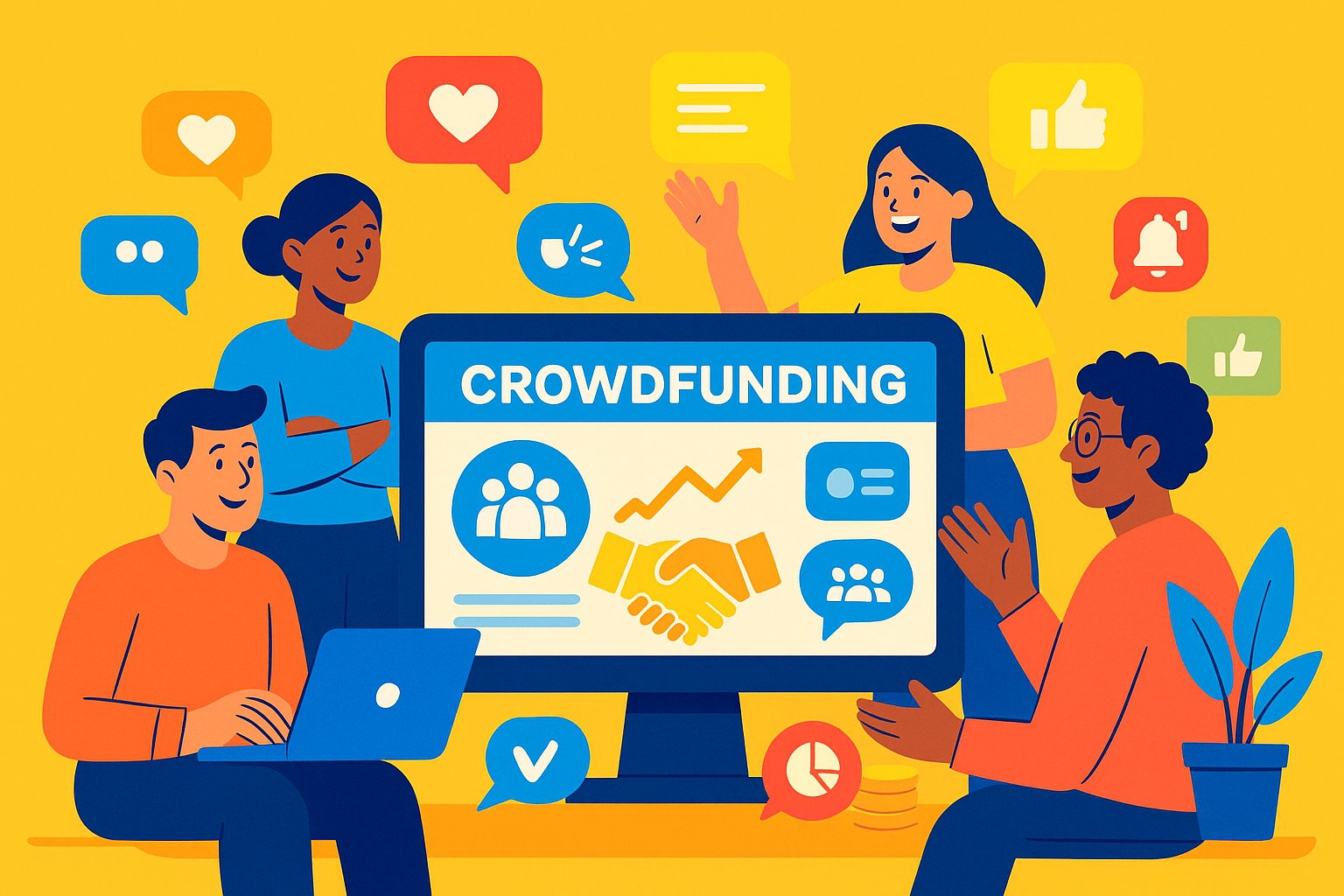Aligning Visions: The Art of Crowdfunded Expectation Management
Crowdfunding campaigns thrive on the boundless enthusiasm of investors eager to back your vision, yet that very zeal can become a double-edged sword if expectations outpace delivery realities. Navigating this dynamic demands more than sporadic updates; it requires a deliberate strategy that harmonizes your startup’s evolving road map with backers’ hopes—and does so with transparent communication, thoughtful education, and proactive engagement. When managed effectively, crowdfunded investors transform from passive financiers into loyal brand ambassadors, fueling referrals, co-creation, and long-term advocacy. In this foundational section, we’ll explore why expectation management is a cornerstone of crowdfunding success and preview the best practices that enable you to both inspire and align your community, ensuring momentum endures long after the funding goal is met.
At the heart of every crowdfunded campaign lies a promise: the promise of innovation, impact, and mutual gain. Backers commit funds based on the narrative and projections you present, envisioning product launches, revenue milestones, and market breakthroughs. Yet the unpredictable nature of startups—longer development cycles, supply-chain hiccups, or shifting market conditions—often contests those initial timelines. Left unaddressed, this misalignment can erode trust, stifle word-of-mouth momentum, and derail follow-on funding. By contrast, founders who proactively set realistic milestones, educate investors on the inherent uncertainties of early-stage ventures, and maintain a cadence of transparent updates cultivate patience and shared ownership. They transform potential frustration into collective problem-solving, rallying their community around both victories and challenges.
In the sections ahead, we’ll look into the multifaceted strategies that underpin best-in-class expectation management. You’ll learn how to craft honest campaign narratives that balance ambition with feasibility, establish communication rhythms that foster ongoing trust, and employ data-driven insights to tailor messages to diverse investor segments. We’ll examine how educational content alleviates misconceptions, how interactive forums invite collaborative feedback, and how corporate governance tools safeguard transparency. By weaving these practices into your crowdfunding playbook, you’ll not only meet backer expectations but elevate them—turning your campaign into a launchpad for sustained advocacy and growth.
Painting a Realistic Roadmap: Setting Clear Milestones from Day One
A successful expectation management strategy begins long before your campaign goes live; it starts with the road map you present to potential backers. Rather than simple bullet-point timelines, craft a narrative that weaves goals, dependencies, and contingency plans into a compelling framework. For instance, instead of promising “Product launch in three months,” articulate “Alpha release in Q2, contingent upon supplier certification and beta testing feedback, with public launch planned for Q3.” By explicitly acknowledging dependencies—regulatory approvals, manufacturing lead times, or iterative user feedback—you educate investors on the multifaceted nature of startup execution.
This approach does more than manage expectations; it fosters empathy. When backers understand the sequence of events and potential external factors that may shift timelines, they are more inclined to grant grace periods and participate in problem-solving discussions. Furthermore, visually mapping your milestones—through infographics or Gantt charts—transforms abstract dates into tangible checkpoints. Incorporating buffer periods into your road map for unforeseen delays demonstrates prudence, reinforcing backers’ confidence that you value their capital enough to avoid unrealistic promises. Setting clear, realistic milestones from Day One thus anchors investor optimism in operational reality, laying the groundwork for sustained alignment.
Transparency in Motion: Establishing a Consistent Communication Cadence
Consistent, transparent communication acts as the lifeline between founders and their crowdfunded community. Once your campaign closes, investors yearn for tangible signals that progress is underway. Establish a predictable update rhythm—such as monthly newsletters or quarterly video briefings—and adhere to it without fail. When backers know exactly when and where to expect news, they remain tuned in and feel acknowledged rather than overlooked.
Each update should combine quantitative data—production volumes, customer acquisition metrics, financial snapshots—with qualitative narrative: team anecdotes, user testimonials, and contextual insights. For example, if a delayed prototype shipped late, frame it within a broader story: describe the technical challenge, the pivot you executed, and the lessons learned that will prevent future setbacks. This layered storytelling not only informs but also humanizes your venture, reinforcing the trust that underpins crowdfunding relationships. Ultimately, a disciplined communication cadence transforms your community from a passive audience into active collaborators, eager to witness each step of your journey.
Educating Your Backers: Building a Knowledgeable Community
Crowdfunded investors often span a spectrum of expertise—from seasoned angel investors to everyday enthusiasts curious about your mission. To harmonize expectations across this diverse audience, invest in educational content that demystifies the mechanics of your industry and startup process. Create explainer videos on key topics—such as regulatory pathways, supply-chain dynamics, or software development cycles—to illuminate the path ahead. Host live webinars where experts unpack complex subjects and field questions in real time, turning passive confusion into interactive learning moments.
Educational initiatives satisfy intellectual curiosity while reducing the likelihood of misaligned expectations. When backers appreciate the nuances of your business model—be it subscription revenue recognition, unit economics, or fundraising mechanics—they’re better equipped to interpret updates and extend patience through inevitable pivots. Moreover, a knowledgeable investor base becomes a valuable asset: they can refer you to domain experts, provide strategic introductions, and serve as ambassadors who articulate your value proposition with accuracy and conviction.
Interactive Engagement: Inviting Investors into the Conversation
Beyond broadcasting updates, foster interactive touchpoints that actively involve backers in your venture’s evolution. Launch an online forum or Slack channel dedicated to investor discussions, where subscribers can propose ideas, share relevant industry insights, and celebrate milestones together. Schedule periodic “town hall” sessions—whether video calls or in-person meetups—where founders present progress and address investor queries directly, demonstrating commitment to two-way dialogue.
Interactive engagement not only strengthens communal bonds but yields strategic dividends. Investor-generated feedback can surface customer pain points, product feature suggestions, and potential partnership leads that might otherwise escape internal teams. Importantly, when investors see their contributions shape decision-making, their emotional and financial commitment deepens. By inviting them into the conversation, you transform your funding base into an empowered advisory network—elevating expectation management from top-down communication to collaborative co-creation.
Segmenting Investor Communications: Personalized Relevance at Scale
As your crowdfunding community grows, a one-size-fits-all messaging approach loses impact. Segment your investor base by criteria such as investment level, professional background, or expressed interests, and tailor communications accordingly. Major contributors might receive exclusive deep-dive reports or access to advisory councils, while smaller backers benefit from digestible executive summaries and overview webinars. Geographic segmentation can enable localized events or regulation-specific updates that resonate with distinct markets.
This nuanced approach shows respect for investors’ time and preferences, increasing the relevance of each message. Personalized communications signal that you see each backer as an individual stakeholder, not merely a line on a cap table. Moreover, targeted feedback requests—such as asking product-focused backers for beta-test insights—yield richer data and heighten engagement. By embedding personalization into your expectation management framework, you ensure that your messages cut through the noise and foster enduring loyalty.
Managing Setbacks with Grace: Turning Challenges into Trust-Building Opportunities
Inevitably, your venture will encounter delays, resource constraints, or strategic pivots that challenge backer expectations. In these moments, silence is the greatest enemy. Craft proactive setback announcements that pair candid disclosure with clear remediation plans. For instance, if a manufacturing partner fails to meet quality standards, explain the issue’s impact, outline your switch to an alternative supplier, and provide an adjusted delivery timeline.
This approach converts potential frustration into empathy by demonstrating accountability. Rather than viewing setbacks as failures, position them as integral steps in your startup’s evolution—opportunities to refine processes and fortify your value proposition. When investors witness your capacity to navigate adversity with transparency and resolve, their trust in your leadership deepens, reinforcing the expectation that you will steer the ship skillfully, even through choppy waters.
Leveraging Data: Measuring Sentiment and Refining Your Approach
Expectation management thrives on continuous improvement, and data-driven insights are your compass. Track metrics such as email open rates, forum participation levels, and webinar attendance to gauge investor engagement. Conduct periodic surveys soliciting feedback on update frequency, content clarity, and preferred communication channels. Analyze sentiment within your community—are questions growing more strategic over time, or do misunderstandings persist?
Armed with these insights, refine your messaging cadence, adjust content formats, and allocate resources to the engagement tactics that yield the highest resonance. For example, if in-depth video briefings consistently outperform email newsletters in click-throughs and feedback volumes, consider shifting your communication budget toward multimedia production. By treating expectation management as an iterative, metrics-driven process, you cultivate a responsive community that feels heard and valued at every step.
Aligning Incentives: Rewarding Advocacy and Participation
Incentive structures can amplify expectation management efforts by turning active backers into motivated ambassadors. Establish referral programs that recognize subscribers who introduce new investors or customers—perhaps through equity bonuses, product discounts, or exclusive access to early features. Gamify participation in forums or feedback sessions by awarding badges or tiered recognition for top contributors.
These incentives reinforce desired behaviors—sharing campaign updates, providing constructive feedback, and evangelizing your brand—while aligning investor expectations around continued engagement. When advocates see tangible rewards tied to their contributions, they become more deeply invested in your venture’s success. Moreover, a culture of recognition fosters healthy competition and communal pride, further entrenching the expectation that every stakeholder has a meaningful role to play.
Sustaining Momentum: Embedding Expectation Management into Your Culture
The most successful crowdfunding organizations view expectation management not as a sporadic initiative but as a core cultural tenet. Integrate community engagement responsibilities into team milestones and performance reviews, ensuring that every department—product, marketing, finance—understands its role in keeping backers informed and aligned. Establish cross-functional governance forums that review investor feedback, track progress against communicated milestones, and surface emerging risks.
By institutionalizing expectation management, you build organizational resilience. When leadership changes or scaling pressures arise, your community engagement engine continues humming, preserving trust and momentum. Crowdfunded investors come to expect—and receive—a seamless, human-centered communication experience, reinforcing their decision to support your journey year after year.
Looking Ahead: Evolving Your Approach as Your Venture Scales
As your startup grows beyond its initial crowdfunding circle, re-evaluate and expand your expectation management toolkit. Incorporate advanced investor-relations platforms that automate personalized updates, facilitate secondary share transfers, and integrate compliance reporting. Launch executive roundtables or investor days that deepen strategic dialogues and offer glimpses into long-term planning. Collaborate with seasoned board members or industry advisors to layer additional credibility onto your communications.
While scaling demands new systems and processes, the principles of transparent, empathetic, and collaborative expectation management remain unchanged. By continually refining your approach—balancing data-driven insights, creative engagement tactics, and deep-seated cultural commitment—you’ll foster a thriving investor ecosystem that not only sustains your crowdfunding success but propels your venture toward enduring market leadership.
Managing crowdfunded investor expectations is a multifaceted discipline that blends strategic foresight, transparent storytelling, and community-driven collaboration. By painting realistic roadmaps, establishing consistent communication rhythms, educating your backers, and inviting them into interactive dialogues, you bridge the gap between entrepreneurial ambition and operational reality. Coupled with data-informed refinements, thoughtful incentives, and a culture that elevates expectation management to organizational priority, these best practices transform your investor community into a potent engine of advocacy and growth. Embrace these strategies, and watch your crowdfunding journey evolve from a one-time funding event into a sustained narrative of shared success.




